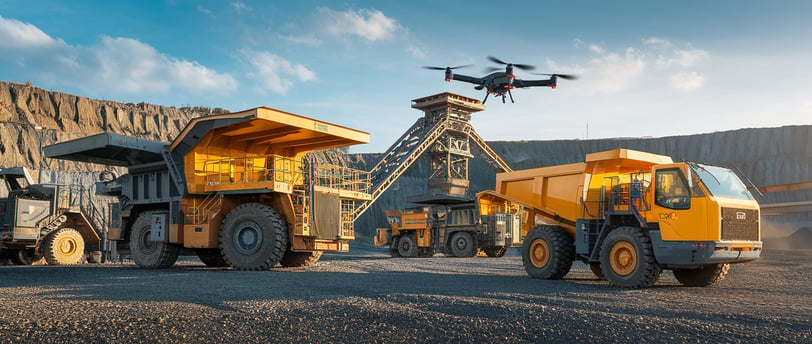How AI is helping the Mining Industry
The mining industry has long been a cornerstone of global economic growth, providing the raw materials essential for everything from infrastructure to technology. However, traditional mining practices often face challenges like inefficiency, safety risks, and environmental concerns. Enter artificial intelligence (AI) a game-changer that’s transforming how the sector operates. In this blog post, we’ll explore how AI is helping the mining industry overcome its biggest hurdles, streamline operations, and pave the way for a smarter, safer, and more sustainable future.


How AI is Revolutionizing the Mining Industry: Boosting Efficiency, Safety, and Sustainability
1. Smarter Exploration with AI-Driven Mineral Discovery
Finding new mineral deposits is time-consuming, costly, and historically reliant on guesswork. Today, AI in mining is revolutionizing exploration by analysing vast datasets—from geological surveys to satellite imagery—to predict where resources like copper, gold, or lithium are most likely to exist. Machine learning algorithms can identify patterns humans might miss, reducing exploration time by up to 50% and slashing costs. Companies like Goldspot Discoveries and Rio Tinto are already using AI to pinpoint high-potential sites, ensuring fewer dry holes and higher returns on investment.
2. Autonomous Vehicles and Robotics: Mining Without Human Risk
One of the most visible applications of AI in the mining industry is the rise of autonomous haulage systems (AHS). Self-driving trucks, drills, and loaders operated by AI now work around the clock in mines from Australia to Chile. These vehicles use sensors, GPS, and real-time data to navigate treacherous terrain, transport materials, and avoid collisions. By removing humans from dangerous environments, companies like BHP and Fortescue Metals Group have reduced workplace accidents while boosting productivity by 20-30%.
3. Predictive Maintenance: Minimizing Downtime, Maximizing Output
Unplanned equipment failures cost the mining industry billions annually. AI solves this through predictive maintenance, where machine learning models analyse sensor data from machinery to predict failures before they happen. For example, vibration patterns from a conveyor belt can signal an impending breakdown, allowing repairs during scheduled downtime. This proactive approach has helped companies like Vale cut maintenance costs by 25% and extend equipment lifespans.
4. Enhancing Safety with AI-Powered Risk Management
Mining is inherently hazardous, but AI is making it safer. Computer vision systems monitor worksites in real time, detecting unsafe behaviours (like missing PPE) or environmental risks (gas leaks, unstable ground). Wearable AI devices track workers’ vital signs, alerting supervisors to heat stress or fatigue. In South Africa, Sibanye-Stillwater uses AI-powered drones to inspect unstable shafts, protecting workers from cave-in risks. These innovations are reducing injuries and saving lives.
5. Sustainable Mining: Reducing Environmental Footprints
The mining sector faces growing pressure to adopt eco-friendly practices. AI aids sustainable mining by optimizing energy use, reducing waste, and monitoring environmental impacts. For instance, AI algorithms can adjust processing plant operations in real time to minimize water and energy consumption. Meanwhile, satellite imagery analysed by AI tracks deforestation or pollution, ensuring compliance with regulations. Companies like Newmont Corporation use these tools to cut carbon emissions and rehabilitate land post-mining.
6. Streamlining Supply Chains with AI Analytics
From extraction to delivery, mining supply chains are complex. AI simplifies this by forecasting demand, optimizing logistics, and managing inventory. Machine learning models predict commodity price fluctuations, helping companies decide when to sell or store materials. Blockchain-integrated AI systems also ensure ethical sourcing by tracing minerals from mine to market—a critical step for conflict-free supply chains.
The Future of AI in Mining: What’s Next?
The integration of AI in mining is still in its early stages, but the potential is limitless. Emerging trends include:
Digital twins: Virtual replicas of mines for real-time simulation and optimization.
Advanced robotics: AI-powered drones for underground mapping and ore sorting.
Generative AI: Accelerating R&D for new extraction techniques.
As AI technology evolves, mines will become safer, greener, and more profitable.
Conclusion
AI is no longer a futuristic concept—it’s a present-day reality reshaping the mining industry. By harnessing machine learning, autonomous systems, and big data analytics, companies are unlocking unprecedented efficiency, safety, and sustainability. For miners, investors, and stakeholders, adopting AI isn’t just an option; it’s a necessity to stay competitive in a rapidly evolving world.
Ready to dig deeper into the AI revolution? Share this post, leave a comment, or subscribe for more insights on how technology is transforming industries!
Explore
Discover premium eBooks across various engaging genres.
Read
Tell us what our next ebook should be about!
© 2025. NEWGENREADS.COM All rights reserved.
